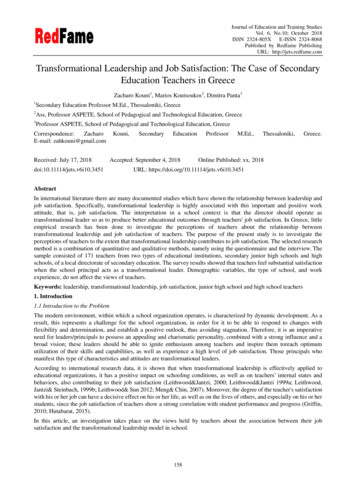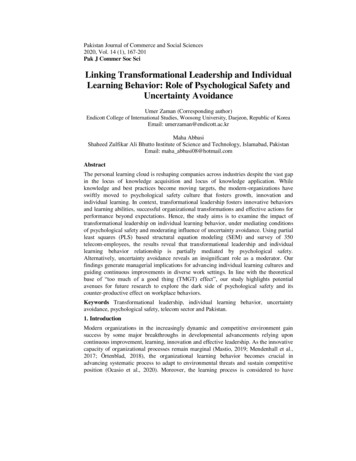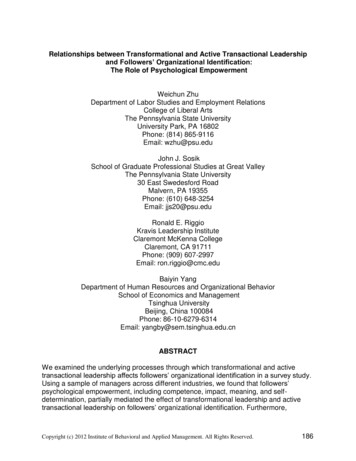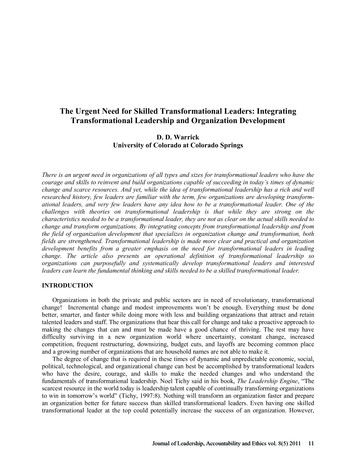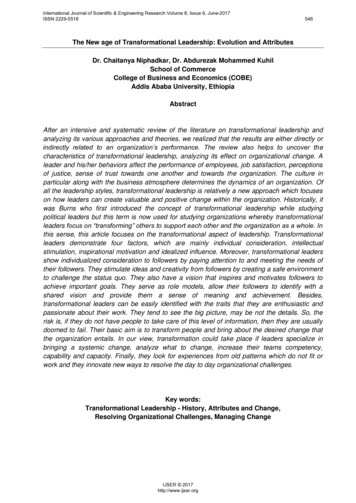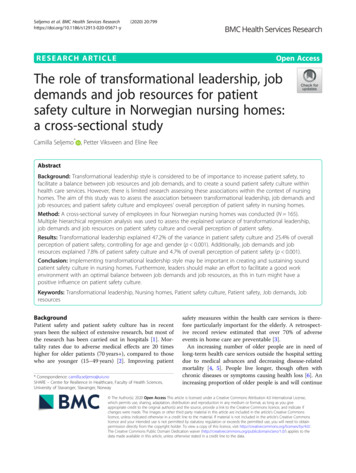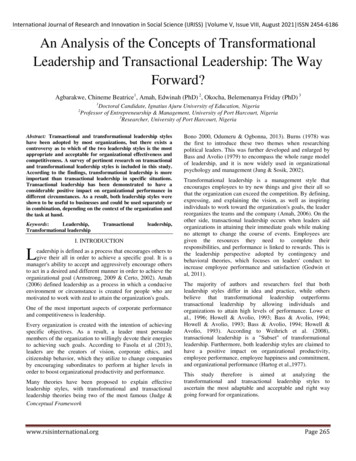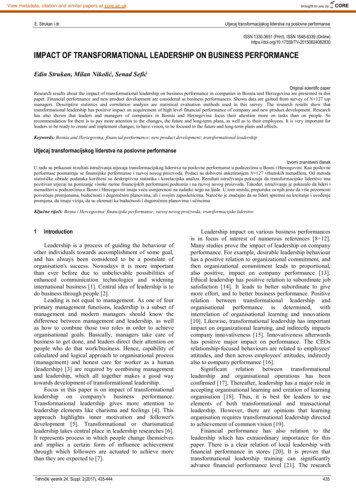
Transcription
View metadata, citation and similar papers at core.ac.ukE. Strukan i dr.brought to you byUtjecaj transformacijskog liderstva na poslovne performanseISSN 1330-3651 (Print), ISSN 1848-6339 IMPACT OF TRANSFORMATIONAL LEADERSHIP ON BUSINESS PERFORMANCEEdin Strukan, Milan Nikolić, Senad SefićOriginal scientific paperResearch results about the impact of transformational leadership on business performance in companies in Bosnia and Herzegovina are presented in thispaper. Financial performance and new product development are considered as business performances. Shown data are gained from survey of N 127 topmanagers. Descriptive statistics and correlation analysis are statistical evaluation methods used in this survey. The research results show thattransformational leadership has positive impact on acquirement of high level financial performance of company and new product development. Researchhas also shown that leaders and managers of companies in Bosnia and Herzegovina focus their attention more on tasks than on people. Sorecommendation for them is to pay more attention to the changes, the future and long-term plans, as well as to their employees. It is very important forleaders to be ready to create and implement changes, to have vision, to be focused to the future and long-term plans and effects.Keywords: Bosnia and Herzegovina; financial performance; new product development; transformational leadershipUtjecaj transformacijskog liderstva na poslovne performanseIzvorni znanstveni članakU radu su prikazani rezultati istraživanja utjecaja transformacijskog liderstva na poslovne performanse u poduzećima u Bosni i Hercegovini. Kao poslovneperformase posmatraju se finansijske performanse i razvoj novog proizvoda. Podaci su dobiveni anketiranjem N 127 vrhunskih menadžera. Od metodastatističke obrade podataka korišteni su deskriptivna statistika i korelacijska analiza. Rezultati istraživanja pokazuju da transformacijsko liderstvo imapozitivan utjecaj na postizanje visoke razine financijskih performansi poduzeća i na razvoj novog proizvoda. Također, istraživanje je pokazalo da lideri imenadžeri u poduzećima u Bosni i Hercegovini imaju veću usmjerenost na zadatke nego na ljude. U tom smislu, preporuka za njih jeste da više pozornostiposvećuju promjenama, budućnosti i dugoročnim planovima, ali i svojim zaposlenicima. Naročito je značajno da su lideri spremni na kreiranje i uvođenjepromjena, da imaju viziju, da su okrenuti ka budućnosti i dugoročnim planovima i učincima.Ključne riječi: Bosna i Hercegovina; financijske performanse; razvoj novog proizvoda; transformacijsko liderstvo1IntroductionLeadership is a process of guiding the behaviour ofother individuals towards accomplishment of some goal,and has always been considered to be a postulate oforganisation's success. Nowadays it is more importantthan ever before due to unbelievable possibilities ofenhanced communication technologies and wideninginternational business [1]. Central idea of leadership is todo business through people [2].Leading is not equal to management. As one of fourprimary management functions, leadership is a subset ofmanagement and modern managers should know thedifference between management and leadership, as wellas how to combine those two roles in order to achieveorganisational goals. Basically, managers take care ofbusiness to get done, and leaders direct their attention onpeople who do that work/business. Hence, capability ofcalculated and logical approach to organisational process(management) and honest care for worker as a human(leadership) [3] are required by combining managementand leadership, which all together makes a good waytowards development of transformational leadership.Focus in this paper is on impact of transformationalleadership on company's business performance.Transformational leadership gives more attention toleadership elements like charisma and feelings [4]. Thisapproach highlights inner motivation and follower'sdevelopment [5]. Transformational or charismaticalleadership takes central place in leadership researches [6].It represents process in which people change themselvesand implies a certain form of influence achievementthrough which followers are actuated to achieve morethan they are expected to [7].Tehnički vjesnik 24, Suppl. 2(2017), 435-444Leadership impact on various business performancesis in focus of interest of numerous references [8 12].Many studies prove the impact of leadership on companyperformance. For example, desirable leadership behaviourhas a positive relation to organizational commitment, andthen organizational commitment leads to proportional,also positive, impact on company performance [13].Ethical leadership has positive relation to subordinate jobsatisfaction [14]. It leads to better subordinate to givemore effort, and to better business performance. Positiverelation between transformational leadership andorganisational performance is determined, withinterrelation of organisational learning and innovations[10]. Likewise, transformational leadership has importantimpact on organizational learning, and indirectly impactscompany innovativeness [15]. Innovativeness afterwardshas positive major impact on performance. The CEOsrelationship-focused behaviours are related to employees'attitudes, and then across employees' attitudes, indirectlyalso to company performance [16].Significant relation between transformationalleadership and organisational operations has beenconfirmed [17]. Thereafter, leadership has a major role inaccepting organisational learning and creation of learningorganisation [18]. Thus, it is best for leaders to useelements of both transformational and transactionalleadership. However, there are opinions that learningorganisation requires transformational leadership directedto achievement of common vision [19].Financial performance has also relation to theleadership which has extraordinary importance for thispaper. There is a clear relation of local leadership withfinancial performance in stores [20]. It is proven thattransformational leadership training can significantlyadvance financial performance level [21]. The research435CORE
Impact of transformational leadership on business performanceinvestigated organizations in the same industry but withdifferent ownership regarding the extent to which CEOsinfluence organization performance [22]. Their resultssuggested that CEO's have influence over firmperformance. CEO empowering leadership has positiveinfluence on top management as well as on companyperformance [9].Organizational effectiveness and high financialperformance require a leader to be cooperative, flexibleand adaptive to environment changes [23]. There areseveral studies regarding how women’s leadership canaffect company's financial performance [24, 25]. Thefindings show that female-led firms were slightly betterthan their male-led counterparts in transmitting marketperformance into financial performance.Regarding the relation between leadership and newproduct development (NPD), numerous studies haveshown that leadership has significant influence on NPD[26, 27, 28]. In the process of new product developmentpace is very important, and some studies emphasizeimportance of leader role in new product developmentspeed-up [29, 30]. One group of studies impliesimportance of leader's experience and expertise for theNPD process, but also the need for NPD market directionand taking care of NPD economic aspects [31, 32].Importance of research presented in this paper comesout of a fact that there are no studies that have dealt withthis topic. Therefore, the basic motive of this paper was tofill this gap and to identify condition of leadership and itsimpact on business performance in companies in Bosniaand Herzegovina. This research has an additionalimportance due to transition conditions, existence ofpublic and private organisations, and recently more andmore foreign companies that do business in Bosnia andHerzegovina.2 Theoretical basis2.1 Transformational leadershipLeaders are individuals who foster motivation of theirfollowers in order to achieve goals of leaders andfollowers as well as possible, and transformationalleadership is a process due to which leader deals withother individuals and makes connections between themand thereby increases motivation and moral level [33].Authentic transformational leadership is socialized tional leaders exceed their own interests for thewelfare of others [34]. Even though, the basic feature oftransformational leaders is pronounced charisma whichimplies domination, having strong aspiration to influenceothers, self-confidence and a strong feeling for individualmoral values. Charismatic leaders often set highexpectations on their followers, and then show them thatthey have confidence in their abilities to fulfil thoseexpectations. By doing so, they encourage the followers’conscience to have necessary competences and to beefficient, which improves their individual performance[35].Transformational leaders of highest level areseparated from their ego and they put it in service of amore important objective, to make an extraordinaryorganisation by transformation. Yet it does not mean they436E. Strukan et al.do not have big ego or personal interests, because they arevery ambitious actually, but their ambition is principallydirected to institution, not to themselves [36].Transformational leadership improves the followers’performance and enables them to develop to full potential[37]. People who show transformational leadership oftenhave numerous strong inner values and ideals, and theyare effective in motivating people to achieve better resultsregardless of their personal interest [38].Transformational leadership model has four factors[39]:(1) Charisma or idealised influence describes the leaderwho is a strong ideal to his followers. Followersidentify themselves with such leaders and want tomatch them. They give the vision and the sense ofmission to their followers.(2) Inspirational motivation is characteristic to leaderswho put high expectations on their followers, inspiretheir motivation to be dedicated to common vision oforganisation.(3) Intellectual stimulus implies leaders who encouragetheir followers to be creative and innovative, and tochallenge themselves to be dedicated to organisationperformance improvement.(4) Individual appreciation represents a leader whomakes support to ambience in which he carefullyconsiders individual needs of his followers, whereleaders act as trainers and counsellors helping theirfollowers to accomplish their potentials completely.There are four strategies that transformational leadersuse to transform the organisation, looking for a chance toachieve more efficiency [40]:(1) Existence of explicit, understandable, useful andincentive vision, set up on the basis of organisation'sneeds, to which will all organisation members refer.(2) Creation of social ambience, by making form andshape for common attitudes of all organisationmembers.(3) Making confidence in organisation by clearlypointing up own attitudes and being consistent intheir realization, which is closely related toreliability.(4) Leader's creative own evolution through positive selfrespect based on self-competences, controlling tasksand general (strategic) organisation objectives.There are five fundamental practises that enableleader to accomplish outstanding results in a creation ofchanges in organisation transformation: path modelling,common vision creation, process review, enabling othersto act and encouragement [41]. Transformationalapproach to leadership is an effective leadership form[42]. Transformational leadership requires managers to beaware of relation of their behaviour to the needs of theirsubordinates and the variable business dynamics of theirorganisation.It is also proven that technology and technologybased alterations do not have crucial relation toorganisation transformation from good to tomatization) can accelerate alterations but it cannotinitialize them, only individuals can do it, respectivelyTechnical Gazette 24, Suppl. 2(2017), 435-444
E. Strukan i dr.transformational leaders. Therefore, first activity oftransformational leader is inventing and implementing ofalterations. Organisational alterations are a process ofchanging current organisation in order to increaseorganisation efficiency, namely a measure of objectiveaccomplishment of the organisation [43]. Actuated bynew technology, widening of global businessopportunities and trend of organisation modernisation,almost all organisations change in some way [44].Alteration is one of the foundations of existence andefficient business activity of the organisation, so leaderswho are able to determine appropriate alterations andsuccessfully implement them afterwards making theirorganisation more flexible and innovative, are veryimportant to those organisations regardless of thestructure and sector they do business in [45].In order to make successful changes, a leader shouldhave special skills, for example skill of solving problemsincurred by alteration implementation, skill of havinginfluence on others, and maybe the most important skillfor this process, ability of determining intensity (extentand quantity) of changes that employees can endure [46].Generally speaking, leaders should introduce only thosealterations which will increase organisation efficiency,within the context of this paper subject, financialperformance and new product performance.2.2 Financial performanceIn this paper the following financial performanceswere researched: profitability, sales growth, asset growth,market share, and competitive status in the firm’sindustry, as well as productivity and salaries. There issignificant interest in these performances in literature, forexample for productivity [47, 48, 49], for salaries [50,51]. From above mentioned references, it is noticed thatissues related to salaries are very actual and significant inless developed countries. That is why this performance isincluded in research in Bosnia and Herzegovina. Based onformer analysis, we formed a set out of seven financialperformances researched in this paper: productivity,profitability, market share, sales growth, competitivestatus, asset growth and employees' salaries.An important item in business activity enhancementof modern business systems is productivity defined as theratio between total produced quantity of goods andservices (outputs), and organisation resources necessaryfor its production (inputs). Productivity is efficiency ofhuman labour usage. Profitability is a set of successindicators, and it compares financial result with investedmoney, sale and dividend cover. It is a basic principle ofcompany's business activity efficiency. Maximization offinancial result (profit) in relation to engaged assets orcapital is required. Market share represents an indicator ofcompany's relative proportion in some market (sector,industry) which is calculated by taking the company'svolume of production (sales) and dividing it by the totalvolume of production (sales) on a relevant market. Salesgrowth as realization of goods and services is the finalphase of reproduction process. Sales are in the basis ofevery business success. In order to realize successfulsales, management's task is to create a situation whereclient (buyer) is satisfied and company has satisfactoryTehnički vjesnik 24, Suppl. 2(2017), 435-444Utjecaj transformacijskog liderstva na poslovne performanseprofit at the same time. Competitiveness growth in allbusiness fields, continuously amplifies impact of marketglobalization and shorter product lifecycle. Companycompetitiveness is a measure of company's capability toproduce goods and services in free and peer marketconditions which pass test of domestic and internationalmarket, and at the same time to keep and long-termincrease successful business activity and company'svalues. Company assets refer to those economic valueswith which it disposes in order to accomplish itsobjectives and tasks. Main features of assets are: they areused in company's business activities in a long period oftime, meanwhile they do not change their shape, theygradually expend by transferring part of their value toproducts or services. Within the context of abovementioned, it is clear that assets growth is an importantfinancial performance for company's growth anddevelopment. Salaries or wages consist of wage for workdone and time spent on work, wage on the basis ofemployee's contributions to business success of employer(awards and bonuses), as well as other incomes in respectof employment, in accordance with the employmentcontract. Even though there are many motivationaltechniques with which managers try to improve workmotivation of their employees as well as their productivity(for example job rotation and flexible working hours),still in countries in transition, such as Bosnia andHerzegovina, most dominant form of influence onmotivation and employee's productivity is the salary as abasic form of financial income.Financial performance is the subject of numerousstudies, especially in terms of determining dependence offinancial indicators from various organizational aspects[47, 48, 50, 52, 53, 54, 55]. Partially observed, someresearchers are directed to studying influence onprofitability and its importance [52, 53, 56], some onstudying productivity [47, 48, 49], and some on studyingsalaries [50, 51, 54].Some references enquire certain sets of the financialperformance. For example, in papers [16, 55, 57] thefollowing financial performances were researched:profitability, sales growth, asset growth, market share,and competitive status in the firm’s industry. In reference[58] the influence of public relations in companies inSerbia on the following financial performance wasanalysed: share of salaries in business revenues,productivity, efficiency, profitability, liquidity, profitmargin (profit share in business revenues), potentialfinancial risks (exchange rate fluctuations, high interestrates and the like).2.3 New product developmentIn this paper, authors decided to examine the impactof leadership on new product development (NPD) besidesthe impact of leadership on financial performance. Whilefinancial performance refers to the current businessresults in some company, NPD refers to the strategicaspect being the best representative of a firm's conditionin the future. In this way the image of the current situationin companies in Bosnia and Herzegovina is completed.Nowadays the product is the basis of the strategicplanning of business. The disproportion of global supply437
Impact of transformational leadership on business performanceand demand leaves modest possibilities in managing withother elements of business, such as distribution andpromotion in the context of market success, if product orservice is not designed and developed in accordance withtarget customer's needs and expectations. If somecompany wants to do business successfully and to becompetitive in the market, it has to put new productdevelopment in its limelight.New product development assumes combination ofvarious activities which ultimately have the same goals: toachieve technical success of new product (functionality inthe technical sense), to achieve customer's satisfactionwith new product (with quality, design, etc.) andsuccessful market positioning or new productcommercialization (successful large scale sales onmarket), with which company returns invested funds indevelopment and launches new product on market andmakes profit. NPD can represent key factor in achievingcompetitive advantage, and sometimes company'ssubsistence [59, 60]. The existence of increasedcompetition on local and on global market, continuousnew product development, often changes of consumer'shabits and needs, shorter product lifecycle lead tocontinuous pressure on company to work constantly onnew product development [61]. A failure in new productdevelopment process can adversely reflect on businessactivity and the future of company [62].3 Research methodology3.1 Survey instruments (measures)A questionnaire used in this research is designed togive all information about features, skills and strategies oftransformational leaders in companies included in thisresearch. It is also designed to be useful for selfevaluation and as a good tool for training anddevelopment of own skills, as well as to give answersabout extent and intensity of achieved financialperformance of the company. Its purpose was to enablemeasurement of transformational leadership, financialperformance and new product development, and to putthem into correlation in order to prove extent andintensity of transformational leadership impact onparticular organisation results, within context of this papersubject, first of all financial performance.Transformational leadership behaviour. In this paper,transformational leadership was measured by more than15 questions (items). Prime five items represent chosenitems from multifactorial query about leadership MLQ,type 5x short [63]. Respondents assessed items throughfive-point Likert scales, ranking from 0 to 4, where gradeshave the following meaning: 0 (not at all), 1 (from time totime), 2 (sometimes), 3 (quite often), 4 (often but notalways). The other ten questions about transformationalleadership refer to extent and intensity of manager'sorganisational and personal efficiency. These questionswere defined according to Transformational LeadershipBehaviour Inventory query (TLI), developed byPodsakoff and associates [64]. The TLI query was alsoused in reference MacKenzie et al. [65], and itsconsistency, reliability and validity were confirmed inpapers of Podsakoff, MacKenzie, & Bommer [66]. Thisquery is modified for the needs of research presented in438E. Strukan et al.this paper. Modifications were done so that top managersanswer these questions, as well as for adaptation ofquestions to conditions in companies in Bosnia andHerzegovina. Assessment of these ten items respondentsmade through seven-point Likert scales ranking from 1(strongly disagree) to 7 (strongly agree).Financial performances. In this paper, as the startingpoint for selection of financial performance to be put intorelation with leadership, the following references weretaken: Tan & Litschert [55]; Wang et al., 2003 [57];Wang et al., 2011 [16]. The following financialperformances were studied in these papers: profitability,sales growth, asset growth, market share, and competitivestatus in the firm’s industry. To this group of fivefinancial performances two more were added:productivity and salaries. There is significant interest inliterature for these performances, for example: forproductivity [47, 48, 49], for salaries [50, 51]. It can beconcluded from the mentioned references that these issuesrelated to salaries are very actual and significant in lessdeveloped countries. That is the reason this performanceis included in research in Bosnia and Herzegovina. On thebasis of the former analysis, the set of seven financialperformances researched in this paper was formed:productivity, profitability, market share, sales growth,competitive status, asset growth and employee's salaries.Respondents made assessment of all items related tofinancial performance in this paper, using five-pointLikert scales ranking from 1 (very low) to 5 (very high). Itwas done in accordance with references [16, 55, 56, 57].New product development. For measuring of successof NPD in this paper, an instrument in accordance withGriffin and Page [67] was used and contains three items:consumer based success, financial success and technicalsuccess. This approach validity is confirmed inreferences: Song, Souder, & Dyer [68]; Souder, Buisson,& Garrett [69]. In reference Belassi et al. [70], these itemswere observed independently, as a separate dimension. Itwas done in this paper too. Also, in this paper respondentsmade assessment of all items related to NPD using sixpoint Likert scales ranking from 1 (very low) to 6 (veryhigh).3.2 Participants and data collectionThe research was done in 127 companies (mostlyproduction companies) from private and state sector inBosnia and Herzegovina, during December 2014, andJanuary, February and March 2015. It included 127managers, mostly top managers, according to theprinciple one organisation-one manager. Before theresearch was done, the purpose and importance ofresearch was explained to them. Questionnaire techniqueand interviews were used as methods of scientificresearch. The research was done anonymously.Data collection process was realised by e-mail orphone contacting company's management. Afterwardsappointments with the representative of management weremade where purpose and importance of research wereexplained. If company's management asked for a letter ofexplanation, authors sent it. After management'simprovement authors contacted top managers and made asurvey.Technical Gazette 24, Suppl. 2(2017), 435-444
E. Strukan i dr.Utjecaj transformacijskog liderstva na poslovne performanseA sample was representative and chosen by includingboth public and private companies with 50 and moreemployees. It was important to include as many sectors aspossible. Companies included in this research weremostly from production sector: machine metal processing,food production, wood processing industry, car industry(car elements production), construction, textile and shoesindustry, pharmaceutical sector. Companies from serviceindustry were also included (trade, banking sector andinsurance companies). Companies from all over Bosniaand Herzegovina were included in this research accordingto regional representation principle.3.3 Objective, mission and hypothesis of researchThe basic objective of this research was to obtainrelevant indicators and to identify the influence extent ofmethods, strategies andknown practices oftransformational leadership on business activitymanagement efficiency, financial performance and newproduct development in mostly production companies inBosnia and Herzegovina. It was extremely important toidentify if there was relation between transformationalleadership dimensions and financial performances,transformational leadership influence and new productdevelopment and total organisation performance, and atwhat extent.The basic task of this research was to identifydirections the operations managers should follow in thefuture, in order to enhance their features, skills,techniques and transformational leader strategies througheducation and training, and to learn the ones they do nothave. Thus they would acquire additional competences foraccomplishment of outstanding results in alterationcreation process during continuous adaptation process toconstant changes of a dynamic business ambience.Current studies mostly show that managers who puttheir employees and their relation to them in theirlimelight are significantly more efficient than managerswho put tasks in their limelight instead of employees whowork on those tasks. In context of mentioned studies,recently there is trend that leaders introduce employees inorganisation's life, giving them freedom to make andimplement decisions in their incidence, which is basis ofmodern leadership and transformational leadership.Hypothesis. According to presented theoretical basisand some other studies, the following hypothesis was setup: There are statically significant positive correlationsbetween transformational leadership items and financialperformance items in companies in Bosnia andHerzegovina.Table 1 Descriptive statisticsItemsAcronymIdealised influence (characteristic). Overlook self-interest forL1(MLQ)the sake of group welfare.Idealised influence (behaviour). Consideration of the moralL2(MLQ)and ethical consequences of decisions.Inspirational motivation. Optimistic performance regardingL3(MLQ)future.Intellectual incentive. Review of the key assumptions in orderL4(MLQ)to check their adequacy.Individual consideration. Helping others to develop theirL5(MLQ)strength.Visionary, forward-looking.L6Ready to create and introduce changes.L7Increasing the productivity of others.L8Getting people to feel like they have the power and they areL9not controlled in every detail.Inducing the best in people.L10Accentuation of long-term effects.L11Improving organizational flexibility.L12Relaxation and calmness.L13Accepting feedback calmly and quietly.L14The interest in FP2Market share.FP3Sales growth.FP4Competitiveness.FP5Assets growth.FP6Salaries.FP7Commercial (financial) success of new products in the past.FP8 (NPD)Technical success of new products in the past.FP9 (NPD)Customer satisfaction of new products in the past.FP10 (NPD)Valid N 127Tehnički vjesnik 24, Suppl. 2(2017), 435-444Min.Max.Arithmetic 42131,113261,016611,036461,339511,331361,50319439
Impact of transformational leadership on business performanceE. Strukan et al.4 Research results4.1 Descriptive statisticsorigin (82,68 %) and 22 have other origin (mostly EUorigin) (17,32 %). 68 organisations are in privateownership (53,54 %), and 59 in state ownership (46,46%).Descriptive statistics for items of transformationalleadership, financial performance and new productdevelopment are shown in Tab. 1 as well as item names,each item acronym, arithmetic mean and standarddeviation.This research was done on a sample of N 127examinees. 87 (68,50 %) respondents w
towards development of transformational leadership. Focus in this paper is on impact of transformational leadership on company's business performance. Transformational leadership gives more attention to leadership elements like charisma and feelings [4]. This approach highlights inner motivation and follower's development [5].
